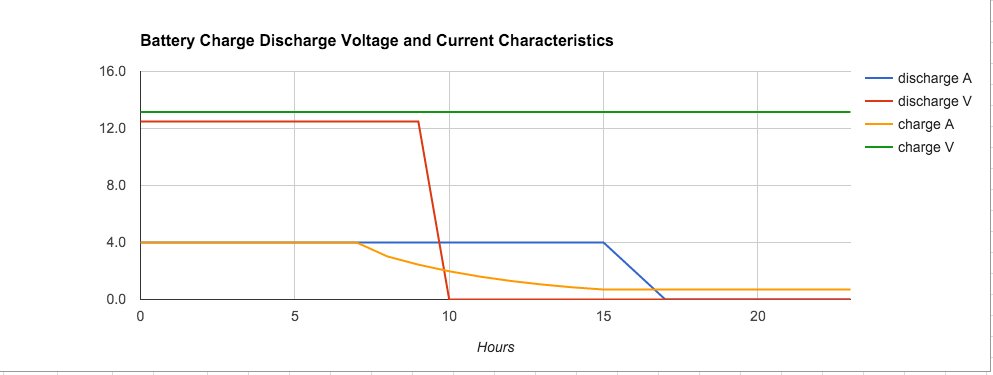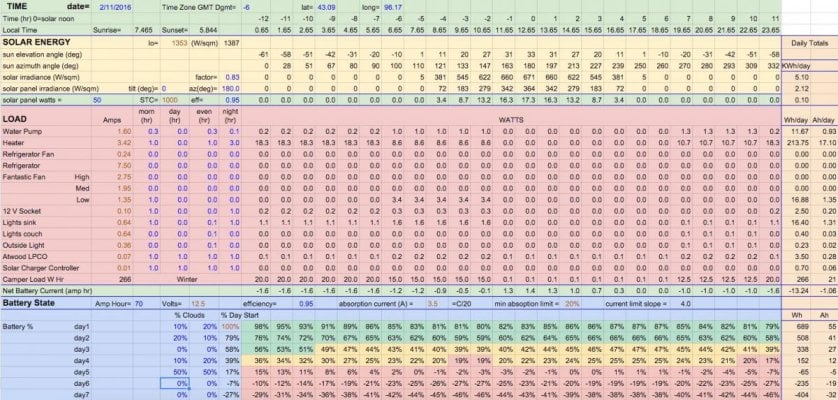carld
Senior Member
In light of some of the discussions on solar power for RVs, I have been working on a comprehensive model for for a small solar application such as an RV or small cabin. This is the Beta version. It models the sun's geometry and solar energy for a specified date and location (lat/long). The model then extrapolates these results out over the next 6 days.
The inputs that the user can modify include the following:
The solar model calculates each hour of the day centered around solar noon, the hour the sun is at its maximum elevation. It finds the sun elevation and azimuth angles and models the direct sun irradiance in watts per square meter. It also finds the relative local time, and sunrise and sunset times. Based on the sun and solar panel geometries, it projects the direct solar energy to the solar panel surface and finds the hourly amount of solar energy captured by the panel during the day. It then extrapolates the energy out for the next 6 days and modifies the energy depending on the user defined morning and day cloud cover.
The system load is determined from the RV appliance currents and the estimated hourly usage for morning, day, evening and night hours. The power for each appliance is allocated to the hours it is used during the day and summed to find the total hourly power amounts. The available power is the solar panel power minus the load power divided by the nominal battery voltage for each hour resulting in amp hours. The column on the right show the daily totals in watt-hours and amp-hours.
The battery introduces some nonlinearities into the system. The hourly battery current for each day is modified using the cloud cover, whether the battery is charging or discharging, and the % charge state of the battery. If the current is negative the battery discharges at a linear rate depending on its capacity. If the current is positive the battery charges at a reduced rate depending on the battery state and battery efficiency. The battery efficiency takes into account that more energy is used to charge the battery (the charge current is at a higher voltage) then is used during discharge (at a lower voltage). When the battery reaches 80% or more, the charge current is limited to the absorption current and may not use all the available solar power. The absorption current is usually specified as the battery amp-hr capacity divided by 20. As the battery charges to 100% the absorption current ramps down to minimum absorption current limit as a per-cent of the absorption current. When the battery reaches 100% no additional solar power is used.
The model runs on Google Sheets. The model will be read only but if you make a copy you change it for your use. If you have the Google app it will work on your phone. Here is shared link for it.
https://docs.google.com/spreadsheets/d/1kh1WAx8Py8Rb8pT8G3XOe1vroTjxDlCk_HrNA8_xtjQ/edit?usp=sharing
I have attached two screen shots showing the model and how it models the battery charge and discharge cycles.
The inputs that the user can modify include the following:
- date and time zone
- latitude and longitude
- Solar panel watts, elevation tilt, and azimuth tilt.
- Battery capacity, voltage, efficiency, absorption current max and minimum.
- Solar irradiance and morning and day % cloud cover.
- RV appliance current measurements and estimated hours of use for morning, day, evening and night.
The solar model calculates each hour of the day centered around solar noon, the hour the sun is at its maximum elevation. It finds the sun elevation and azimuth angles and models the direct sun irradiance in watts per square meter. It also finds the relative local time, and sunrise and sunset times. Based on the sun and solar panel geometries, it projects the direct solar energy to the solar panel surface and finds the hourly amount of solar energy captured by the panel during the day. It then extrapolates the energy out for the next 6 days and modifies the energy depending on the user defined morning and day cloud cover.
The system load is determined from the RV appliance currents and the estimated hourly usage for morning, day, evening and night hours. The power for each appliance is allocated to the hours it is used during the day and summed to find the total hourly power amounts. The available power is the solar panel power minus the load power divided by the nominal battery voltage for each hour resulting in amp hours. The column on the right show the daily totals in watt-hours and amp-hours.
The battery introduces some nonlinearities into the system. The hourly battery current for each day is modified using the cloud cover, whether the battery is charging or discharging, and the % charge state of the battery. If the current is negative the battery discharges at a linear rate depending on its capacity. If the current is positive the battery charges at a reduced rate depending on the battery state and battery efficiency. The battery efficiency takes into account that more energy is used to charge the battery (the charge current is at a higher voltage) then is used during discharge (at a lower voltage). When the battery reaches 80% or more, the charge current is limited to the absorption current and may not use all the available solar power. The absorption current is usually specified as the battery amp-hr capacity divided by 20. As the battery charges to 100% the absorption current ramps down to minimum absorption current limit as a per-cent of the absorption current. When the battery reaches 100% no additional solar power is used.
The model runs on Google Sheets. The model will be read only but if you make a copy you change it for your use. If you have the Google app it will work on your phone. Here is shared link for it.
https://docs.google.com/spreadsheets/d/1kh1WAx8Py8Rb8pT8G3XOe1vroTjxDlCk_HrNA8_xtjQ/edit?usp=sharing
I have attached two screen shots showing the model and how it models the battery charge and discharge cycles.


